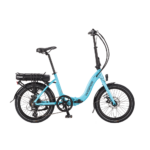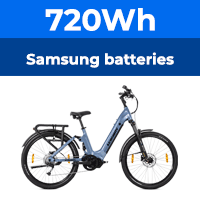Met Office: Weather and climate change contains a lot of much more useful weather observations/forecasts than the mainstream media. (the reason the broadcast forecasts are inaccurate is that cost-cutting means they are not updated as regularly as they should be). comparing the last few hours observations with current weather has always mostly kept me out of the rain and I commute every day (I am lucky to have flexible office hours).
Phylion battery and charger.
- Thread starter Pete
- Start date
That is a good idea, and an interesting take on using flexi time. Our weather tends on the whole to be a mixture of things throughout the day, except when we get stable high pressure systems sitting over us, and that won't bring any wet, so I can see it is quite possible to dodge the rain quite often.
So, if weather puts you off commuting by bike - as the boss if you can work flexi time.
So, if weather puts you off commuting by bike - as the boss if you can work flexi time.
Unless they have changed the design, the Phylion charger has a small LED on the top, at the battery lead end. When charging this LED will show red, changing to green when the battery is full.
Once that LED turns to green, the charger will latch out, and not start again even if the pack voltage drops as a result of the cells balancing. If the charger LED is showing green then the battery is full.
Once that LED turns to green, the charger will latch out, and not start again even if the pack voltage drops as a result of the cells balancing. If the charger LED is showing green then the battery is full.
That is useful to know Bob. That is what has happened already so there must have been a fair charge in the battery already as it went from red to green in little over an hour. I thought I had read somewhere, but may have been in respect of another battery/charger that the charger would cycle between red and green once nominally fully charged and this meant it was balancing the cells?Unless they have changed the design, the Phylion charger has a small LED on the top, at the battery lead end. When charging this LED will show red, changing to green when the battery is full.
Once that LED turns to green, the charger will latch out, and not start again even if the pack voltage drops as a result of the cells balancing. If the charger LED is showing green then the battery is full.
Reply With Quote
Pete
Hi Pete,
I'm beginning to have some thoughts about that first charger, I'm starting to think it may not be faulty after all. Assuming you hadn't noticed the LED charge status indicator on the charger, do you think it was possibly showing green (latched out) when you thought it was not working. Perhaps then removing the charge lead from the battery and testing for output, but, without first switching the charger off at the mains to reset the latch. In other words, If the charger LED was showing green when checking for output, there would be no voltage showing at the plug because the charger was still latched out following the battery becoming full.
Sorry if this sounds patronising, but I think it might be worthwhile trying the first charger again, perhaps after your first test ride. If it turns out to be working then just say nowt and keep it as a spare.
Just a thought
Regards
Bob
I'm beginning to have some thoughts about that first charger, I'm starting to think it may not be faulty after all. Assuming you hadn't noticed the LED charge status indicator on the charger, do you think it was possibly showing green (latched out) when you thought it was not working. Perhaps then removing the charge lead from the battery and testing for output, but, without first switching the charger off at the mains to reset the latch. In other words, If the charger LED was showing green when checking for output, there would be no voltage showing at the plug because the charger was still latched out following the battery becoming full.
Sorry if this sounds patronising, but I think it might be worthwhile trying the first charger again, perhaps after your first test ride. If it turns out to be working then just say nowt and keep it as a spare.
Just a thought
Regards
Bob
Not at all, good advice, well meant is always welcome.I'm beginning to have some thoughts about that first charger, I'm starting to think it may not be faulty after all. Assuming you hadn't noticed the LED charge status indicator on the charger, do you think it was possibly showing green (latched out) when you thought it was not working. Perhaps then removing the charge lead from the battery and testing for output, but, without first switching the charger off at the mains to reset the latch. In other words, If the charger LED was showing green when checking for output, there would be no voltage showing at the plug because the charger was still latched out following the battery becoming full.
Sorry if this sounds patronising, but I think it might be worthwhile trying the first charger again, perhaps after your first test ride. If it turns out to be working then just say nowt and keep it as a spare.
I see what you are getting at Bob but I was aware of the light on the charger and it never got off red. As I said earlier I couldn't measure any output from it so maybe it has 'latched out' somehow even though the indicator was showing red? The info is still worth knowing though, I had no idea that they switched out in this way.
On a lighter note maybe this is what we should all have, a battery with fantastic range: World's biggest battery switched on in Alaska - Telegraph
Pete,
I've been thinking about your misunderstanding of how the chargers differ. I will only speak of chargers with which I have personal experience...there may be others.
The phylion and Wisper chargers latch out when the battery is full and remain so until switched off.
It's possible you may have read about the chargers supplied by Li Ping with his LiFePO4 batteries. This charger remains constantly active whilst switched on. The Ping BMS (his own design) will allow the chargers output to pass until the whole battery reaches the target voltage, around 42 volts. The BMS will then block the chargers output and commence balancing the individual cells. If the whole pack voltage is then below the target voltage, the BMS will then allow the chargers output to once again enter the array. This sequence will be repeated until the whole pack voltage remains at target after cell balancing.
Speeding up the conditioning of a new battery. Phylion and Wisper
After discharging the new battery to near empty, recharge in the normal way until the charger switches off. Switch off and disconnect the charger from both mains and battery. Allow the battery to rest for four or five hours. Hook the charger up to the battery and switch on the mains. Chances are, the charger will resume chargeing for around twenty minutes, squeezing a further 60 odd watt-hours into the battery.
All the best
Bob
I've been thinking about your misunderstanding of how the chargers differ. I will only speak of chargers with which I have personal experience...there may be others.
The phylion and Wisper chargers latch out when the battery is full and remain so until switched off.
It's possible you may have read about the chargers supplied by Li Ping with his LiFePO4 batteries. This charger remains constantly active whilst switched on. The Ping BMS (his own design) will allow the chargers output to pass until the whole battery reaches the target voltage, around 42 volts. The BMS will then block the chargers output and commence balancing the individual cells. If the whole pack voltage is then below the target voltage, the BMS will then allow the chargers output to once again enter the array. This sequence will be repeated until the whole pack voltage remains at target after cell balancing.
Speeding up the conditioning of a new battery. Phylion and Wisper
After discharging the new battery to near empty, recharge in the normal way until the charger switches off. Switch off and disconnect the charger from both mains and battery. Allow the battery to rest for four or five hours. Hook the charger up to the battery and switch on the mains. Chances are, the charger will resume chargeing for around twenty minutes, squeezing a further 60 odd watt-hours into the battery.
All the best
Bob
Many thanks Bob, that sounds like a really good tip. It was fully charged last night and as it is raining I am not tempted to go out on the bike just yet so will try re-connecting it to the charger now.After discharging the new battery to near empty, recharge in the normal way until the charger switches off. Switch off and disconnect the charger from both mains and battery. Allow the battery to rest for four or five hours. Hook the charger up to the battery and switch on the mains. Chances are, the charger will resume chargeing for around twenty minutes, squeezing a further 60 odd watt-hours into the battery.
You are probably right, and likey it was another one I am thinking about. I have read so much stuff on here over the last couple of weeks its getting scrambled in the brain.It's possible you may have read about the chargers supplied by Li Ping with his LiFePO4 batteries. This charger remains constantly active whilst switched on. The Ping BMS (his own design) will allow the chargers output to pass until the whole battery reaches the target voltage, around 42 volts. The BMS will then block the chargers output and commence balancing the individual cells. If the whole pack voltage is then below the target voltage, the BMS will then allow the chargers output to once again enter the array. This sequence will be repeated until the whole pack voltage remains at target after cell balancing.
Does this mean the Ping one is a better type of charger or is it just doing automatically what your tip for a bit extra does?
Do you know if chargers are interchangeable or very specific to battery types?
The battery management system you mentioned, are the electronics for that in the charger, in the battery, or both?
Sorry for all the questions, just better I think if you at least have some understanding of how things work.
Pete
This is the chrome mirror I fitted to my Mistral.. less than £5 from Halfords. Easy to fit and works very well.Ok Bob, being up to speed from reading all these great posts I know what you mean!
On a practical point do you know of a mirror which will fit the mistral? Having started using a mirror on my normal bike I now feel very vulnerable when I don't have one. It is made a bit worse by the fact that I am deaf and rarely hear anything coming up behind until it is passing me! The one I use now is a nice little round Cateye one which goes into the end of the handlebar, but the throttle seems to rule that out unless the grip can be pared back?
Pete

I sent for instructions and received 17 pages of instructions - headed Synergie Allegro, Avanti, Bayamo, Brio, Futuro, Mistral, Vivace and ZephrJust taken delivery today of a new Synergie Mistral. ( I will post re experience later)
While I was putting it together I put the battery on to charge. After an hour I used the charge check button on top of the battery and Nothing lit up. I put the battery on the bike and power meter showed all red.
Checked the output from the charger - zero.
NB just found that the lights on the battery pack itself don't work unless the 'ignition' switch is on! It shows two green lights out of 3 so how does this square with all red lights on the bikes meter?
Some instructions wouldn't come amiss, and I have pointed this out to Synergie. I have seen this complaint before, don't any of these suppliers send out any instructions for the electric side of things? If it hadn't been for this forum I wouldn't have had a clue.
Contacted Synergy who said faulty charger and they are sending another one out.
Pete
The last two pages were specific to the Mistral.
Word for word instructions I received..
Mistral Instructions:
Charging the Battery
The Mistral uses a Lithium battery and must be charged using the following method:
Charging is best done overnight or during the day if the bike is going to be used the next day.
Remove the battery from the bike, ensure the key is in the "OFF" position during charging.
The charger should be left on until the battery charger light changes colour and switches off. Only then can the battery be considered as fully charged.
General Riding notes:
Pedal assistance motor is connected at all times.
There will be no power to the motor if "E" (economy)/"S" (sport) switch on handlebars is in the middle setting.
Handlebars
Insert the handlebars into head tube at the desired height, making sure the maximum height mark is not exposed and that the brake and gear cables are not tangled. Adjust the alignment of the handlebars by looking down the stem and lining it up with the front wheel, remember to re-tighten the expander bolt.
Dynamo wiring instructions were also included in the form of a diagram.
.
Pete
Yes, regarding the Ping, that's correct. Theoretically, you could leave the Ping charger permanently connect and switched on if the battery was placed in storage. As the cells self-discharge, the BMS would allow the charger to top up the array as required. The cells used by Li Ping have an extremely low rate of self-discharge, so it would be neither safe nor practical to do that.
The BMS is an integral part of the battery, the charger is closely matched to the BMS's characteristics, so it's best to only use the charger supplied with the battery. There are of course, many people with a vast knowledge of electronics who will confidently use a different charger, but I'm not one of them. All of my chargers are clearly marked as to which battery they were supplied with.
The weather down this way has been quite good, breezy, but long periods of sunshine and mild temperatures. I haven't been out riding though. I'm busy harvesting this years leaf-fall, plently of lovely leaf-mould in a couple of years time.
All the best
Bob
Yes, regarding the Ping, that's correct. Theoretically, you could leave the Ping charger permanently connect and switched on if the battery was placed in storage. As the cells self-discharge, the BMS would allow the charger to top up the array as required. The cells used by Li Ping have an extremely low rate of self-discharge, so it would be neither safe nor practical to do that.
The BMS is an integral part of the battery, the charger is closely matched to the BMS's characteristics, so it's best to only use the charger supplied with the battery. There are of course, many people with a vast knowledge of electronics who will confidently use a different charger, but I'm not one of them. All of my chargers are clearly marked as to which battery they were supplied with.
The weather down this way has been quite good, breezy, but long periods of sunshine and mild temperatures. I haven't been out riding though. I'm busy harvesting this years leaf-fall, plently of lovely leaf-mould in a couple of years time.
All the best
Bob
Thanks for the posts kal I appreciate the information. The mirror looks like a good bet if you don't want too operate on your bike as Flecc and Bob seem to!
The only thing I can see might be a problem is that up some of the rough stuff where I ride frequently might be a bit much for it with the weight at the end of that long arm. Still at that price I will try it and see.
Bob, thanks. I wasn't intending to experiment with another charger, just wondering how it all worked and if the charger is matched to the battery that's it.
Your tip about putting the battery back on to charge didn't work, the green light coming on after a second and you could hear it switching out. It might still work though as you were talking about doing that when charging after a full discharge, so it was probably a bit meaningless as it was.
Leaves, tell me about it. I have it almost year round from an enormous willow tree which sheds leaves all the time, and at this time of year it is obviously is just more of the same only a bit worse.
As I couldn't get out I decided to have a good look round the bike, tighten nuts etc. I turned it upside down and noticed that the steel box stuffed with electrics was in no way sealed to the elements - there was a gap of a few mm along the long sides of the box and given it position it will regularly get soaked. So on the basis of no knowledge at all about what was in there but knowing that electrics and water don't mix I sealed the whole lot with clear silicone. Likewise with the cables going in and out, as there weren't any grommets fited. Also treated where the wiring goes through the axle
into the motor. This wiring seemed very tight at that point and I sense that any movemement there would likey do some damage to it.
As far as the box under the crank, I thought after I had done it, that maybe it was like that for a reason - that any water that does get in could drain out! Any idea about this, think I should have just left it?
The only thing I can see might be a problem is that up some of the rough stuff where I ride frequently might be a bit much for it with the weight at the end of that long arm. Still at that price I will try it and see.
Bob, thanks. I wasn't intending to experiment with another charger, just wondering how it all worked and if the charger is matched to the battery that's it.
Your tip about putting the battery back on to charge didn't work, the green light coming on after a second and you could hear it switching out. It might still work though as you were talking about doing that when charging after a full discharge, so it was probably a bit meaningless as it was.
Leaves, tell me about it. I have it almost year round from an enormous willow tree which sheds leaves all the time, and at this time of year it is obviously is just more of the same only a bit worse.
As I couldn't get out I decided to have a good look round the bike, tighten nuts etc. I turned it upside down and noticed that the steel box stuffed with electrics was in no way sealed to the elements - there was a gap of a few mm along the long sides of the box and given it position it will regularly get soaked. So on the basis of no knowledge at all about what was in there but knowing that electrics and water don't mix I sealed the whole lot with clear silicone. Likewise with the cables going in and out, as there weren't any grommets fited. Also treated where the wiring goes through the axle
into the motor. This wiring seemed very tight at that point and I sense that any movemement there would likey do some damage to it.
As far as the box under the crank, I thought after I had done it, that maybe it was like that for a reason - that any water that does get in could drain out! Any idea about this, think I should have just left it?
It's best not to seal the controller housing, as you say, the idea is to allow any water to immediately drain away. It's best to allow a little air circulation in there to prevent any sweating. The controller itself is hermetically sealed so it's only the connectors that may get damp.
In the unlikely event of any erratic running in the future, you could disconnect each plug and socket and give it a little squirt of repellant such as WD40, do them one at a time so as not to get them muddled.
Sealing the cable entry into the motor is a good idea, it will also act as a cushion to prevent any chaffing.
I can't remember if you have ridden an electric before, if not, then take a little care to start with. Some find it disconcerting when the motor kicks in when starting off. Just the lightest touch on either brake will immediatly cut the power. The Mistral is a very user friendly bike, it doesn't have any of the bad habits that some machines display.
I'd better let you remove that sealant before it cures. A wet rag if water based, white spirit (turps substitute) if spirit based. Give the paintwork a good coat of Autoglym or similar wax polish, Keep it nice and shiny!!
All the best
Bob
In the unlikely event of any erratic running in the future, you could disconnect each plug and socket and give it a little squirt of repellant such as WD40, do them one at a time so as not to get them muddled.
Sealing the cable entry into the motor is a good idea, it will also act as a cushion to prevent any chaffing.
I can't remember if you have ridden an electric before, if not, then take a little care to start with. Some find it disconcerting when the motor kicks in when starting off. Just the lightest touch on either brake will immediatly cut the power. The Mistral is a very user friendly bike, it doesn't have any of the bad habits that some machines display.
I'd better let you remove that sealant before it cures. A wet rag if water based, white spirit (turps substitute) if spirit based. Give the paintwork a good coat of Autoglym or similar wax polish, Keep it nice and shiny!!
All the best
Bob
Inside that steel box, under the bottom bracket, is a motor controller for the brushed motor fitted to the Mistral.Thanks for the posts kal I appreciate the information. The mirror looks like a good bet if you don't want too operate on your bike as Flecc and Bob seem to!
The only thing I can see might be a problem is that up some of the rough stuff where I ride frequently might be a bit much for it with the weight at the end of that long arm. Still at that price I will try it and see.
Bob, thanks. I wasn't intending to experiment with another charger, just wondering how it all worked and if the charger is matched to the battery that's it.
Your tip about putting the battery back on to charge didn't work, the green light coming on after a second and you could hear it switching out. It might still work though as you were talking about doing that when charging after a full discharge, so it was probably a bit meaningless as it was.
Leaves, tell me about it. I have it almost year round from an enormous willow tree which sheds leaves all the time, and at this time of year it is obviously is just more of the same only a bit worse.
As I couldn't get out I decided to have a good look round the bike, tighten nuts etc. I turned it upside down and noticed that the steel box stuffed with electrics was in no way sealed to the elements - there was a gap of a few mm along the long sides of the box and given it position it will regularly get soaked. So on the basis of no knowledge at all about what was in there but knowing that electrics and water don't mix I sealed the whole lot with clear silicone. Likewise with the cables going in and out, as there weren't any grommets fited. Also treated where the wiring goes through the axle
into the motor. This wiring seemed very tight at that point and I sense that any movemement there would likey do some damage to it.
As far as the box under the crank, I thought after I had done it, that maybe it was like that for a reason - that any water that does get in could drain out! Any idea about this, think I should have just left it?
[/ATTACH][/ATTACH]
.
Attachments
-
83.1 KB Views: 12
-
92.1 KB Views: 70
I thought that might be the reply, as I said as soon as I had finished it I realised I had made a mistake. Unfortunately I had used clear silicone which as everybody knows is wonderful stuff but has a magical property of going everywhere you don't want it to. So I just had to leave it to cure and I will take it off later, as it is still teeming down and I think yet another day without trying the bike.It's best not to seal the controller housing, as you say, the idea is to allow any water to immediately drain away. It's best to allow a little air circulation in there to prevent any sweating. The controller itself is hermetically sealed so it's only the connectors that may get dam
Well that is how daft I am I didn't even twig that it would be the controller inside the box, no idea where I thought it might be mind.Inside that steel box, under the bottom bracket, is a motor controller for the brushed motor fitted to the Mistral.
I must admit that I am worried about this because it is just so tight into the axle and leaves it very tight at 90 degrees. Would be interested to know whether yours is the same? When I turn the bike over to remove the sealant from the controller housing I am going to see if I can recover a bit of slack into the cable. Common sense tells me that this is not going to last long otherwise. On the face of it there shouln't be any movement at that point but when a bike is getting shaken about everything moves.Sealing the cable entry into the motor is a good idea, it will also act as a cushion to prevent any chaffing.
I will try and get a reasonable photo of it for others to compare.
Pete
There's only two wires going to the motor, They are small diameter high current wires, It's pretty tough stuff. It's a bit like the telephone cable they string across roads without a catenary. The sheathing also gives them added protection
Should you ever want to remove the back wheel, perhaps to change a tyre or tube, Then it's very easy on the Mistral with just two bullet connectors in the controller housing to disconnect. There is spare cable length available if you want to satisfy your need for peace of mind.
All the best
Bob
Should you ever want to remove the back wheel, perhaps to change a tyre or tube, Then it's very easy on the Mistral with just two bullet connectors in the controller housing to disconnect. There is spare cable length available if you want to satisfy your need for peace of mind.
All the best
Bob
Thanks for that Bob. That time will come sooner or later as I am not one of those people who can change an innertube or tyre while still on the bike, it just always goes wrong! I might actually want to do it sooner rather than later because the tyres look very grippy, ok for off road but not for tarmac I don't think.
Today was washed out again I am just hoping for a bit of dry tomorrow.
Nearly forgot there was one other thing I meant to ask - lights. Now call me thicko, but why are we supplied with a dynamo for lights when we are carting around enough battery power to light up a house? I haven't bothered to fit the lights and dynamo as I will use battery powered LEDs but there must be a way of connecting lights up to the main battery?
Pete
Today was washed out again I am just hoping for a bit of dry tomorrow.
Nearly forgot there was one other thing I meant to ask - lights. Now call me thicko, but why are we supplied with a dynamo for lights when we are carting around enough battery power to light up a house? I haven't bothered to fit the lights and dynamo as I will use battery powered LEDs but there must be a way of connecting lights up to the main battery?
Pete
Some machines do have lights running off the main battery, the Rush Trek for example. It even has a quite loud electric horn incorporated into the headlight.
The Mistrals dynamo is a pretty dim affair, many don't even bother to fit it. Personally I used the threaded mounting bracket for mounting my computer sensor unit. Modern battery powered lights using high intensity LED's are far better. I don't know too much about any of them as I never ride after dark, even the wheel reflectors get taken off.
Weather!, It's down here as well now, the wind is increasing by the minute.
The Mistrals dynamo is a pretty dim affair, many don't even bother to fit it. Personally I used the threaded mounting bracket for mounting my computer sensor unit. Modern battery powered lights using high intensity LED's are far better. I don't know too much about any of them as I never ride after dark, even the wheel reflectors get taken off.
Weather!, It's down here as well now, the wind is increasing by the minute.
Traditionally not done for range reasons Pete, tungsten bulbs being quite greedy and range being a problem on many e-bikes. LEDs are less greedy so this kind of lighting is creeping in, but doing it properly with voltage conversion to suit the low voltage requirements of LEDs means added cost, so the systems so far have generally been cheap botches and less than satisfactory.Now call me thicko, but why are we supplied with a dynamo for lights when we are carting around enough battery power to light up a house?
Personally I find all lighting included with any new bikes isn't up to standard and I wish manufacturers would leave lights right off, reduce the bike price accordingly and leave it to owners to add decent lighting. Many of us never ride in the dark so don't need lights anyway.
.
Related Articles
-
 MTF Enterprises announces acquisition of EMU Electric Bikes
MTF Enterprises announces acquisition of EMU Electric Bikes- Started by: Pedelecs
-
 Wisper 806T folding bike wins Which? ‘Best Buy’
Wisper 806T folding bike wins Which? ‘Best Buy’- Started by: Pedelecs
-
 Sustrans calls for protected cycle lanes
Sustrans calls for protected cycle lanes- Started by: Pedelecs
-
 Amazon launch their first UK e-cargo micromobility hub
Amazon launch their first UK e-cargo micromobility hub- Started by: Pedelecs





